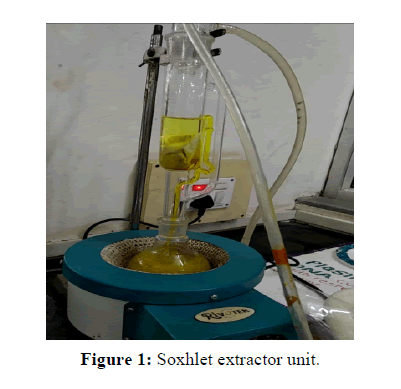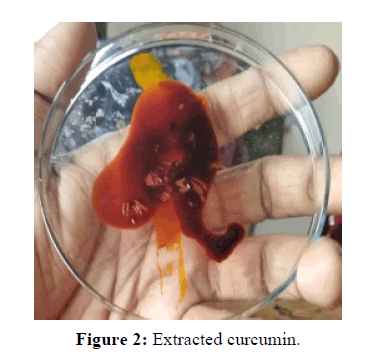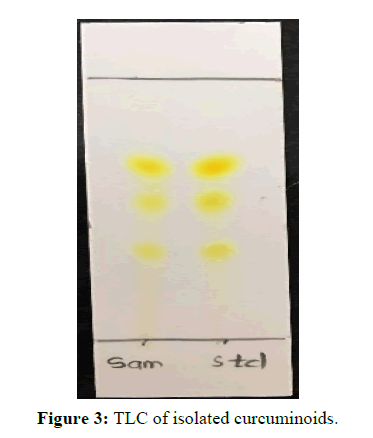ISSN : 2249 - 7412
Asian Journal of Plant Science & Research
Extraction and Purification of Curcumin from Turmeric
Naresh D Joshi*, Aditya A Kulkarni, Makarand N Cherekar
Department of Biotechnology and Bioinformatics, Mahatma Gandhi Mission’s, Nanded, India
Abstract
Turmeric has long been used as a strong anti-inflammatory in Indian systems of drugs. Traditionally turmeric was called "Indian saffron" because of its deep yellow-orange color and it has been used as a condiment, healing remedy and textile dye. Turmeric is rich in curcuminoids which vary in chemical structures, physico-chemical characteristics. The present work reports on extraction method of curcuminoids using Soxhlet extractor unit. Purification and quantification of curcuminoids was carried out by thin layer chromatography. In the TLC maximum resultant extract (by Hexane) was performed Percentage yield of curcumin was reported 4.09% from Soxhlet extraction method. Different solvent were used for extraction, among them acetone showed maximum yield of each curcuminoids. Separation of curcuminoids was tested in TLC chloroform: methanol at 95:5 showed RF value at 0.59, 0.61, and 0.58 as curcumin, di-methoxy-curcumin, bis de-methoxy-curcumin respectively.
Keywords
Turmeric; Curcuminoids; Soxhlet extractor unit; TLC
Introduction
Turmeric (Curcuma longa l.) is medicinal plant which mostly found in south Asia. Turmeric has long been used as a powerful anti-bacterial, anti-oxidant and anti-inflammatory in Indian systems of medicine. Traditionally turmeric was called "Indian saffron" because of its deep yellow-orange color and it has been used as a condiment, healing remedy and textile dye. Turmeric is rich in curcuminoids which vary in chemical structures, physico-chemical characteristics [1].
Curcumin, demethoxycurcumin and bisdemethoxycurcumin these three compounds are present in turmeric. Commonly these three compounds called as curcuminoid. Curcumin is main compound present in turmeric which gives yellow color to turmeric plant. Curcumin is very expensive and act as anti-cancer agent, which is good supplement to avoid growth of cancerous cells in the body. Asian/Indian farmers can sold curcumin as secondary most valuable product compare to turmeric in the market for farmers curcumin work as Agri-gold. In the present work we focused on extraction purification and quantification of curcuminoids using Soxhlet extractor unit [2].
Materials and Methods
Substrate
Curcuma longa (turmeric) local variety collected from Nanded District. All solvents /chemicals used were of AR grade and obtained from Himedia. The salem, china salem, Krishna, these local variety of turmeric was selected. Fresh rhizomes of turmeric were used for extraction. Collected rhizomes were washed, cut into small pieces and oven dried and powdered for extraction [3].
Method of extraction
Curcuminoids was extracted by using Soxhlet extraction method Fresh rhizomes were cleaned, washed with deionsed water, sliced and dried in the sun for one week and dried again at 50ºC in a hot air oven for six hours. These Dried rhizomes were cut in small pieces, powdered by electronic mill. 6 gm of sample were taken into a thimble and placed in a Soxhlet apparatus; 250 ml of solvent was added and extracted according to their boiling point for seven hours. The solvents used were chloroform (BP=61ºC), methanol (BP=65˚c) and acetone (BP=56.53ºC) [4].
After completion of extraction the dark brown extract was then cooled, concentrated using rotary evaporator. This crude dried extract which was turning black orange in colour. Each raw sample of turmeric was extracted by an equivalent method and yield was calculated [5].

Separation of curcuminoids by TLC
Acetone and Methanol solvent extracts were tested on TLC for presence different curcuminoids. The thin layer chromatography pre-coated silica gel plates were used, these plates were developed using glass beaker, which was pre-saturated with mobile phase for 20 min and each plate was developed up to a height of about 6.8 cm. chloroform: methanol mobile phase was used with the 95:5 composition [6]. After development of chromatogram, plates were removed, dried and spots were analyzed [7].
Results and Discussion
Different collected varieties of turmeric from Nanded district, Maharashtra were used to study of soxhlet extraction method for Curcuminoids from turmeric (Figure 1). After drying Soxhlet extract were weighted and weight percentage of curcuminoids were calculated. In this study we used three local varieties of turmeric, Selam, Kadappa and China selam, for extraction. The dried powder was made and used for Soxhlet extraction method using different solvents, this extract in the form of dark black orange colour obtained once dried (Figures 1 and 2).
Extracted curcuminoids dried and quantified, the percentage of extracted curcuminoids showed in Table 1. Among all varieties of turmeric china selam showed highest curcuminoids that is 4.2% using acetone solvent. Methanol is also good solvent for extraction of curcuminoids Maximum concentration of curcuminoids was obtained in acetone solvent compared to ethanol and methanol.
| Variety | Solvent | Curcuminoid (%) |
|---|---|---|
| Selam (10 gm) |
Ethanol | 3.6 |
| Methanol | 3.4 | |
| Acetone | 3.9 | |
| Kadappa (10 gm) |
Ethanol | 3.1 |
| Methanol | 3.7 | |
| Acetone | 3.8 | |
| China selam (10 gm) |
Ethanol | 3.3 |
| Methanol | 4.0 | |
| Acetone | 4.2 |
Table 1: Extraction of curcuminoids using Soxhlet method.
Dried curcuminoids sample were run on TLC for separation of curcuminoids, which showed three different spots of C, DMC, BDMC (Figure 3). we got RF value at 0.59, 0.61, and 0.58 as curcumin, di-methoxy-curcumin, bis -demethoxy- curcumin respectively. According to the RF values of standard curcumin we analyzed presence of curcumin in the sample.
Conclusion
In this study, we extracted natural curcuminoids by soxhlet extractor. We found among all varieties of turmeric china selam showed highest curcuminoids that is 4.2% using acetone solvent. As curcumin is medicinal one and valuable product compare to turmeric in the market for farmers, so it can extract and sold as Agri-gold for farmers. In this present work we found that acetone and china selam gives better results for curcumin extraction. In future further work should carry out to test medicinal properties of curcumin.
Acknowledgments
Honorable chairman and Principal of Mahatma Gandhi Mission’s College of Computer Science and IT, Nanded is thanked for providing all infrastructure facility.
References
- Kulkarni SJ, Maske KN, Budre MP, Mahajan RP. Extraction and purification of curcuminoids from Turmeric (Curcuma longa L.). Int J Pharmacol Pharmaceut Technol. 2017.
- Aggarwal BB, Kumar A, Bharti AC. Anticancer potential of curcumin: Preclinical and clinical studies. Anticancer Res. 2003. 23:363-398.
- Nabati M, Mahkam M, Heidari H. Isolation and characterization of curcumin from powdered rhizomes of turmeric plant marketed in Maragheh city of Iran with soxhlet technique. J Iran Chem Commun. 2014, 2:236-243.
- Paramapojn S, Gritsanapan W. Radical scavenging activity determination and quantitative chemical analysis of curcuminoids in Curcuma zedoaria rhizome extracts by HPLC method. Curr Sci. 2009, 97:1069-10107
- Schieffer GW. Pressurized liquid extraction of curcuminoids and curcuminoid degradation products from 25 turmeric (Curcuma longa) with subsequent HPLC assays. J Liq Chromatogr Relat Technol. 2002, 25:3033-3044.
- Almeida LP, Cherubino APF, Alves RJ, Dufosse L, Gloria MBA. Separation and determination of the physico-chemical characteristics of curcumin, demethoxycurcumin, bisdemethoxycurcumin. Food Res Int. 2005, 38:1039-1044.
- Revathy S, Elumalai S, Benny M, Antony B. Isolation, Purification and Identification of Curcuminoids from Turmeric (Curcuma longa L.) by Column Chromatography. J Exp Sci. 2011, 2(7):21-25.

Open Access Journals
- Aquaculture & Veterinary Science
- Chemistry & Chemical Sciences
- Clinical Sciences
- Engineering
- General Science
- Genetics & Molecular Biology
- Health Care & Nursing
- Immunology & Microbiology
- Materials Science
- Mathematics & Physics
- Medical Sciences
- Neurology & Psychiatry
- Oncology & Cancer Science
- Pharmaceutical Sciences



